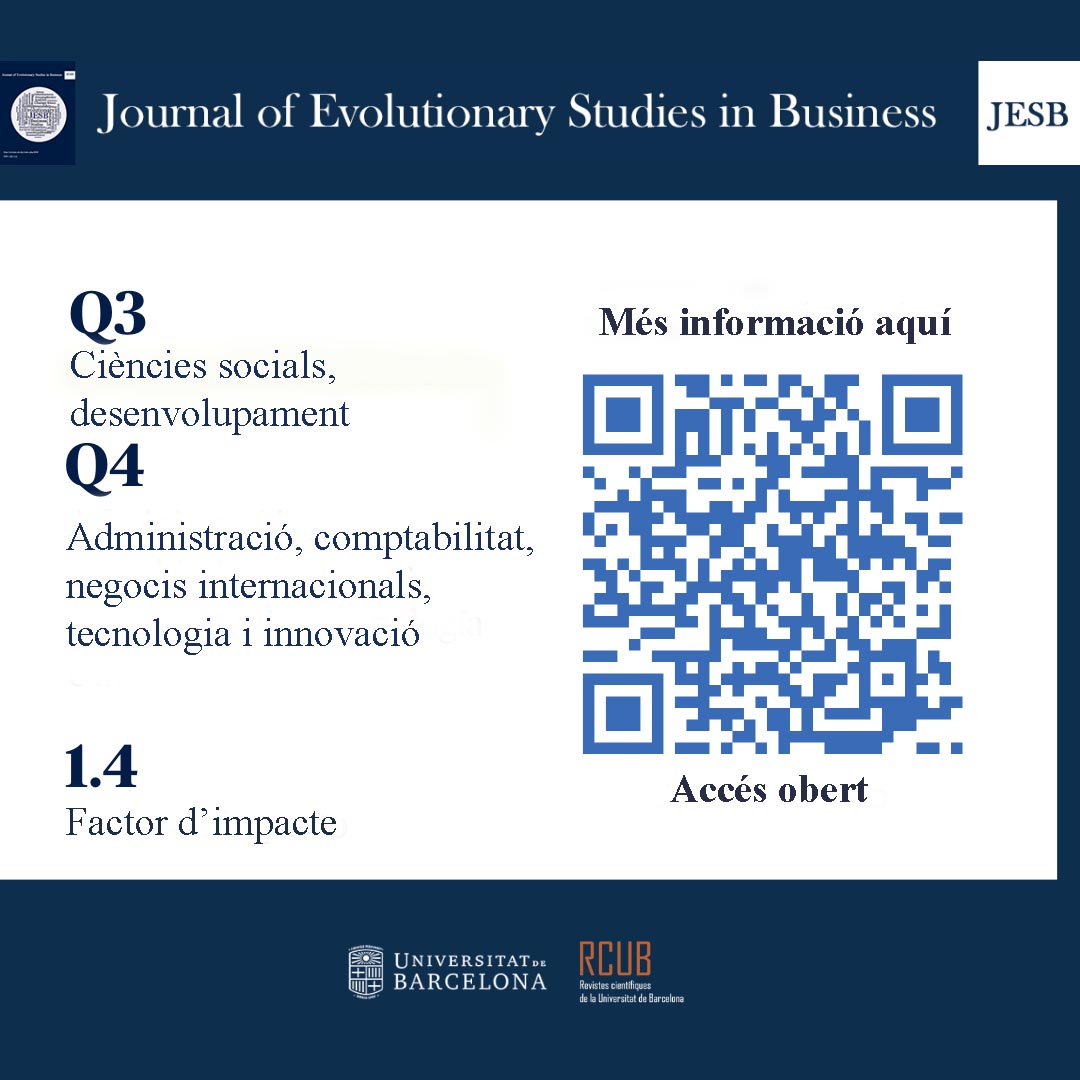Internacionalització dels clústers: una anàlisi comparativa qualitativa (QCA) dels clústers industrials municipals
DOI:
https://doi.org/10.1344/jesb2024.44090Paraules clau:
internacionalització, clúster, competència hortizontal, coordinació vertical, fsQCAResum
Aquest estudi preten examinar la internacionalització dels clústers, un motor de l'auge de les empreses multinacionals dels mercats emergents. Hem explorat la qüestió des del coneixement i la dimensió relacional dels clústers. Examinem com la configuració de quatre factors, és a dir, el coneixement dels components, el coneixement de l'arquitectura, la competència horitzontal i la coordinació vertical, dins d'un clúster afecten conjuntament el grau d'internacionalització del clúster mitjançant l’ús del mètode d'anàlisi comparativa qualitativa de conjunts difusos (fsQCA). Utilitzant les dades de 34 clústers municipals a la ciutat de Suzhou, Xina, hem identificat tres models que condueixen a un alt nivell d'internacionalització de clústers.
Descàrregues
Referències
Amdam Rolv, Peter, Lunnan Randi, Bjarnar Ove, Halse Lise LLillebrygfjeld. 2020. “Keeping Up with the Neighbors: the Role of Cluster Identity in Internationalization.” Journal of World Business 55(5), 101125. https://doi.org/10.1016/j.jwb.2020.101125.
Alcácer Juan, Zhao Minyuan. 2012. “Local R&D Strategies and Multilocation Firms: the Role of Internal Linkages.” Management Science 58(4): 734-753.
Boyer Kenneth K., Leong G. Keong, Ward Peter T., and Krajewski Lee J. 1997. “Unlocking the Potential of Advanced Manufacturing Technologies.” Journal of Operations Management 15(4): 331-347. https://doi.org/10.1016/S0272-6963(97)00009-0.
Canina Linda, Enz Cathy A., Harrison Jeffrey S. 2005. “Agglomeration Effects and Strategic Orientations: Evidence from the U.S. Lodging Industry.” Academy of Management Journal 48(4): 565-581. https://doi.org/10.5465/amj.2005.17843938.
David Paul A., Greenstein Shane. 1990. “The Economics of Compatibility Standards: An Introduction tto Recent Research.” Economics of Innovation & New Technology 1(1-2): 3-41. https://doi.org/10.1080/10438599000000002.
Douglas, Evan J., Shepherd Dean A., and Prentice Catherine. 2020. “Using Fuzzy-Set Qualitative Comparative Analysis for a Finer-Grained Understanding of Entrepreneurship.” Journal of Business Venturing 35(1): 105970. https://doi.org/10.1016/j.jbusvent.2019.105970.
Du Yunzhou, and Kim Phillip H. 2021. “One Size Does Not Fit All: Strategy Configurations, Complex Environments, and New Venture Performance in Emerging Economies.” Journal of Business Research 124: 272-285. https://doi.org/10.1016/j.jbusres.2020.11.059.
Fiss, Peer C. 2011. “Building Better Causal Theories: A Fuzzy Set Approach to Typologies in Organization Research.” Academy of Management Journal 54(2):393-420.
Folta Timothy B., Cooper Arnold C., and Baik Yoon-suk. 2006. “Geographic Cluster Size and Firm Performance.” Journal of Business Venturing 21(2):217-242. https://doi.org/10.1016/j.jbusvent.2005.04.005.
Greckhamer Thomas, Furnari Santi, Fiss Peer C., and Aguilera Ruth V. 2018. “Studying Configurations with Qualitative Comparative Analysis: Best Practices in Strategy and Organization Research.” Strategic Organization 16(4): 482-495. https://doi.org/10.1177/1476127018786487.
Jia, Liangding, Sali Li, Steve Tallman, and Yanquin Zheng. 2017. “Catch‐up Via Agglomeration: a Study of Township Clusters.” Global Strategy Journal 7(2): 193-211. https://doi.org/10.1002/gsj.1154.
Kaufmann Patrick J., Stern Louis W. 1988. “Relational Exchange Norms, Perceptions of Unfairness and Retained Hostility in Commercial Litigation.” Journal of Conflict Resolution 32(3): 534-552.
Lamin Anna, Livanis Grigorios 2013. “Agglomeration, Catch-Up and the Liability of Foreignness in Emerging Economies.” Journal of International Business Studies 44: 579-606. https://doi.org/10.1057/jibs.2013.14.
Leland Hayne E., Quacks, and Lemons. 1979. “Licensing: A Theory of Minimum Quality Standards.” Journal of Political Economy 87(6): 1328-1346.
Marshall, Alfred. 1920. Principles of economics (8th ed.). London: Macmillan.
Maskell, Peter. 2001. “Towards a Knowledge-Based Theory of the Geographical Cluster.” Industrial and Corporate Change 10(4): 921-943. https://doi.org/10.1093/icc/10.4.921.
McCann Brian T., Folta Timothy B. 2008. “Location Matters: Where We Have Been and Where We Might Go in Agglomeration Research.” Journal of Management 34(3):532-565. https://doi.org/10.1177/0149206308316057.
Mesquita Luiz F, Lazzarini Sergio Giovanetti. 2008. “Horizontal and Vertical Relationships in Developing Economies: Implications for Smes' Access to Global Markets.” Academy of Management Journal 51(2):359-380.
Misangyi, Vilmos F., Acharya Abhijith G. 2014. “Substitutes or Complements? A Configurational Examination of Corporate Governance Mechanisms.” Academy of Management Journal 57(6):1681-1705. https://doi.org/10.5465/amj.2012.0728.
Mudambi Ram, Li Lee, Ma Xufei, Makino Shige, Qian Gongming, and Boschma Ron. 2018. “Zoom in, Zoom Out: Geographic Scale and Multinational Activity.” Journal of International Business Studies 49:929-941. https://doi.org/10.1057/s41267-018-0158-4.
Palay, Thomas M. 1984. “Comparative Institutional Economics: the Governance of Rail Freight Contracting.” Journal of Legal Studies 13(2): 265-287.
Porter Michael E. 1998. “Clusters and the New Economics of Competition.” Harvard Business Review 76(6): 77-90.
Porter, Michael E. 2000. “Location, Competition, and Economic Development: Local Clusters in a Global Economy.” Economic Development Quarterly 14(1): 15-34. https://doi.org/10.1177/089124240001400105.
Ragin Charles C. 2008. Redesigning social inquiry: Fuzzy sets and beyond. Chicago, IL: University of Chicago Press.
Schmitz Hubert. 1995. “Collective Efficiency: Growth Path for Small‐Scale Industry.” Journal of Development Studies 31(4): 529-566. https://doi.org/10.1080/00220389508422377.
Schneider Carsten Q, Wagemann Claudius. 2012.Set-theoretic methods for the social sciences: A guide to qualitative comparative analysis. Cambridge: Cambridge University Press.
Tallman Stephen, Jenkins Mark, Henry Nick, and Steven Pinch. 2004. “Knowledge, Clusters, and Competitive Advantage.” Academy of Management Review 29(2): 258-271.
Tendler, Judith, and Mônica Alves Amorim. 1996. “Small firms and their helpers: Lessons on demand.” World Development 24(3):407-426. https://doi.org/10.1016/0305-750X(95)00155-6.
Descàrregues
Publicades
Com citar
Número
Secció
Llicència
Drets d'autor (c) 2024 Journal of Evolutionary Studies in Business

Aquesta obra està sota una llicència internacional Creative Commons Reconeixement-NoComercial 4.0.




